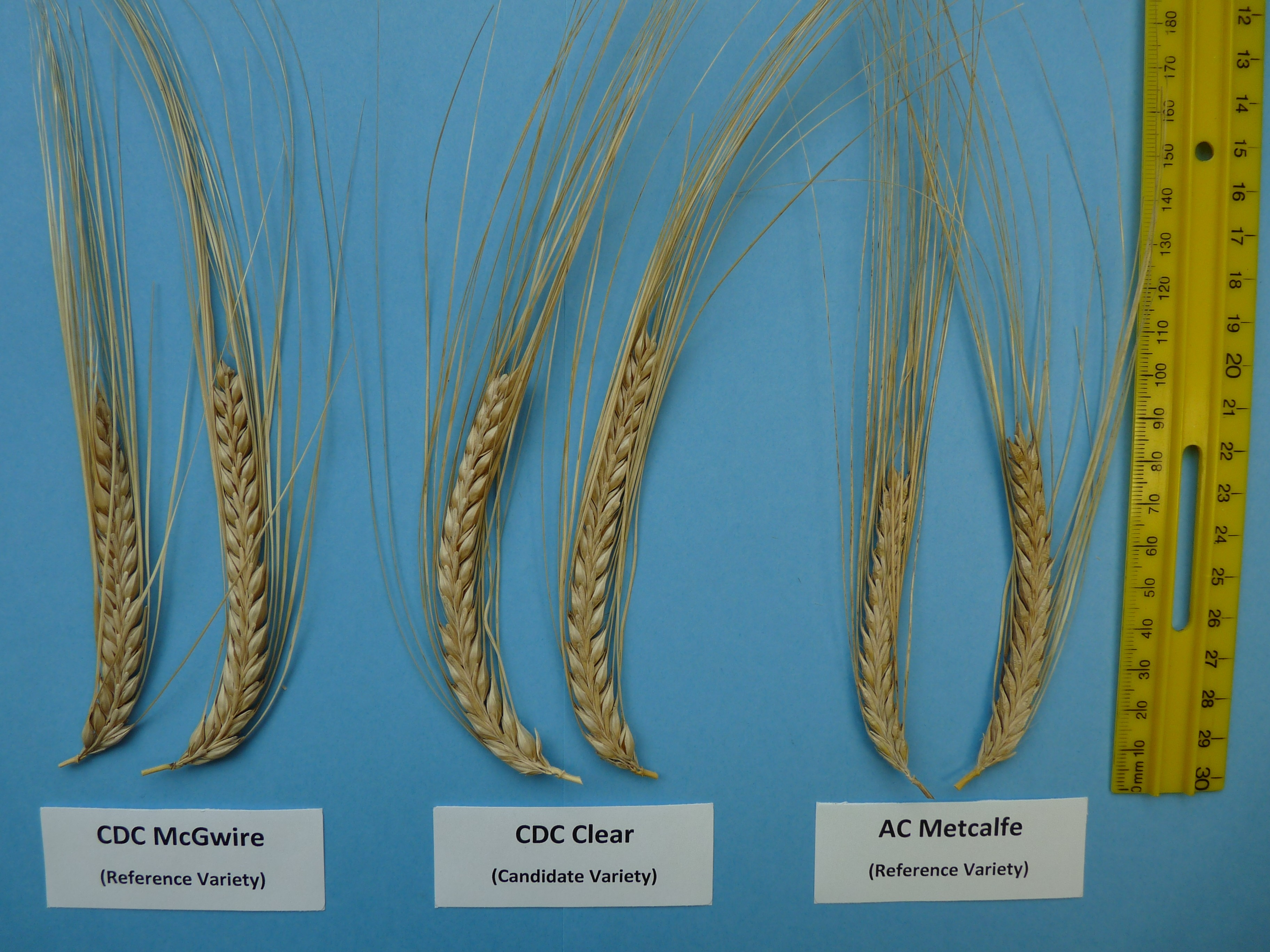CDC Clear
| Denomination: | 'CDC Clear' |
|---|---|
| Botanical Name: | Hordeum vulgare |
| Applicant/Holder: |
University of Saskatchewan Crop Development Centre 4D36 Agriculture Building, 51 Campus Drive Saskatoon, Saskatchewan S7N 5A8 Canada |
| Breeder: |
Aaron Beattie, University of Saskatchewan, Saskatoon, Saskatchewan |
| Application Date: | 2012-04-20 |
| Application Number: | 12-7598 |
| Grant of Rights Date: | 2013-11-25 |
| Certificate Number: | 4652 |
| Grant of Rights Termination Date: | 2031-11-25 |
Variety Description
Varieties used for comparison: 'AC Metcalfe' and 'CDC McGwire'
Summary: 'CDC Clear' has a medium frequency of plants with recurved flag leaves at the booting stage whereas 'AC Metcalfe' has a low frequency. 'CDC Clear' has a wider flag leaf at booting than the reference varieties. The anthocyanin colouration of the nerves of the lemma are weak for 'CDC Clear' whereas it is absent or very weak for 'AC Metcalfe'. At the beginning of ripening, the plant height, which includes the awns, of 'CDC Clear' is taller than 'AC Metcalfe'. 'CDC Clear' has a longer spike, excluding the awns, than 'AC Metcalfe'. 'CDC Clear' is a hulless barley whereas 'AC Metcalfe' is not. 'CDC Clear' has a greater 1000 kernel weight than 'CDC McGwire'. The percent of protein content of 'CDC Clear' is lower than the reference varieties. 'CDC Clear' is resistant to True Loose Smut (Ustilago nuda) whereas 'CDC McGwire' is susceptible.
Description:
PLANT: two row, spring malting-type barley, intermediate growth habit at tillering, absent or very sparse pubescence on the lower leaf sheaths
FLAG LEAF (AT BOOTING): medium frequency of plants with recurved flag leaves, medium pubescence on blade
AURICLES: weak to medium intensity of anthocyanin colouration, weak pubescence on the margins
FLAG LEAF SHEATH: strong glaucosity, very sparse to sparse pubescence
SPIKE: mid-season emergence, medium glaucosity, semi-erect attitude, platform to cup collar shape, parallel sided shape, medium to dense, the sterile spikelet attitude is parallel to weakly divergent, glume and awn of the median spikelet is equal to the grain, weak to medium anthocyanin colouration of the nerves of the lemma of the kernel
FIRST SEGMENT OF RACHIS: medium length, medium curvature
LEMMA AWNS: medium intensity of anthocyanin colouration of the tips, longer than the length of the spike, semi-smooth to rough spiculations on margins
KERNEL: whitish aleurone layer, long rachilla hairs, husk absent, very weak to medium spiculation of inner lateral nerves of dorsal side of lemma, hairiness of ventral furrow absent, clasping disposition of lodicules, transverse crease to incomplete horseshoe shape of basal markings, medium to long, medium width
AGRONOMIC CHARACTERISTICS: fair to good resistance to lodging, good resistance to shattering, good tolerance to straw breakage, fair to good tolerance to drought, good malting quality
DISEASE REACTION: resistant to True Loose Smut (Ustilago nuda)
Origin & Breeding History: 'CDC Clear' (experimental designations HB08304 & SH05161) was derived from a cross between HB365 / 'CDC Trey' during 2001 at the Crop Development Centre, University of Saskatchewan using a pedigree breeding system. HB365 = 'CDC Freedom' / TR251 and 'CDC Trey' = TR333 / ND13167. The F1 through F4 generations were grown as bulk populations with the F1 and F3 grown in winter nurseries in New Zealand. 'CDC Clear' was grown and selected as a single F4 derived F5 row plot at Saskatoon in 2004. The seed was harvested and bulked as the line SH05161. 'CDC Clear' was tested in CDC yield trials in 2005-2007 followed by testing in the Western Canadian Hulless Barley Cooperative Registration Trials as HB08304 during 2008-2009. The selection criteria used in developing 'CDC Clear' included good agronomic performance in improved malting quality including higher extract and lower beta-glucan, and above average disease resistance for loose and surface-borne smuts, spot-form net blotch and stem rust.
Tests & Trials: Tests and trials were conducted during the 2011 and 2012 growing seasons in Saskatoon, Saskatchewan. Plots consisted of 5 rows with a row length of 3.66 metres and a row spacing of 20 cm. There were 3 replicates arranged in a RCB design. Measured characteristics were based on 20 measurements each year.
Comparison tables for 'CDC Clear' with reference varieties 'AC Metcalfe' and 'CDC McGwire'
Flag leaf width at booting (mm)
| 'CDC Clear' | 'AC Metcalfe' | 'CDC McGwire' | |
|---|---|---|---|
| mean 2011 | 9.45 | 8.50 | 8.40 |
| std. deviation | 1.10 | 0.51 | 0.50 |
| mean 2012 | 8.25 | 6.60 | 6.70 |
| std. deviation | 1.21 | 1.57 | 1.22 |
Plant height (including awns) at the beginning of ripening (cm)
| 'CDC Clear' | 'AC Metcalfe' | 'CDC McGwire' | |
|---|---|---|---|
| mean 2011 | 101.40 | 96.30 | 98.45 |
| std. deviation | 4.48 | 3.88 | 3.55 |
| mean 2012 | 75.3 | 72.0 | 76.7 |
| std. deviation | 4.3 | 4.5 | 5.2 |
Spike length (excluding awns) at the beginning of ripening (cm)
| 'CDC Clear' | 'AC Metcalfe' | 'CDC McGwire' | |
|---|---|---|---|
| mean 2011 | 9.67 | 7.48 | 9.71 |
| std. deviation | 0.89 | 0.57 | 1.01 |
| mean 2012 | 10.84 | 7.83 | 9.38 |
| std. deviation | 0.78 | 0.56 | 0.74 |
1000 kernel weight (grams)
| 'CDC Clear' | 'AC Metcalfe' | 'CDC McGwire' | |
|---|---|---|---|
| mean 2011 | 49.7 | 48.4 | 41.3 |
| mean 2012 | 47.8 | 43.1 | 38.2 |
Protein content (%)
| 'CDC Clear' | 'AC Metcalfe' | 'CDC McGwire' | |
|---|---|---|---|
| mean | 11.3 | 11.6 | 12.4 |
Click on image for larger view

Barley: 'CDC Clear' (centre) with the reference varieties 'CDC McGwire' (left) and 'AC Metcalfe' (right)
- Date modified: